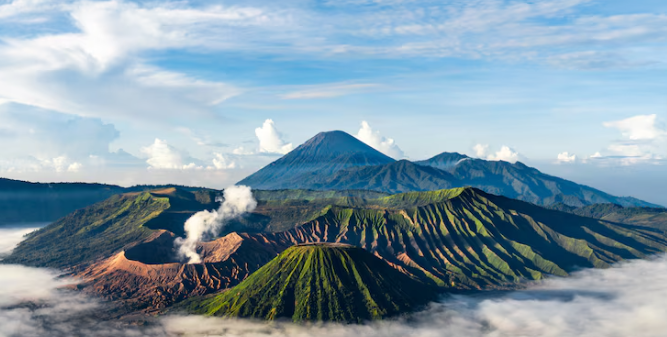
What makes a volcano truly dangerous?
It’s not just size or frequency . . . it’s unpredictability, location, and the global ripple effect it causes. If you’ve ever wondered which volcanic region could shut down flights, choke ecosystems, and send ash across continents, then Kamchatka deserves your attention. And by the end of this article, you’ll understand why it’s one of the most dangerous volcanic zones on Earth—and why you likely haven’t heard enough about it.
Why Kamchatka’s Volcanoes Matter More Than You Think
The Kamchatka Peninsula in Russia is home to over 300 volcanoes, 29 of which are active. Nestled between the Pacific Ocean and the Sea of Okhotsk, it lies on the “Ring of Fire”, where tectonic plates clash like titans. This makes Kamchatka a pressure cooker of seismic activity, capable of releasing explosive energy with little warning.
But it’s not just geography. It’s what these volcanoes can do.
Eruptions in Kamchatka can hurl ash up to 15 kilometers into the sky, threatening international aviation, triggering tsunami alerts, and releasing climate-altering gases. And because it’s so remote, many of these eruptions go unnoticed by the general public . , . until it’s too late.
An Opposing View: Isn’t Kamchatka Too Isolated to Matter?
It’s fair to wonder, how can a volcano in a distant, icy region affect you?
Some argue that because Kamchatka is sparsely populated, its eruptions are less dangerous. After all, what’s a little ash when no one’s around to breathe it in?
However, isolation can be deceptive.
“Kamchatka’s eruptions pose a significant hazard to trans-Pacific air travel,”
states the Smithsonian’s Global Volcanism Program
(volcano.si.edu).
In fact, commercial airliners flying between North America and Asia frequently pass through Kamchatka’s airspace. Volcanic ash can shut down jet engines, damage instruments, and force emergency landings. So while humans might not live near these volcanoes, planes full of them fly overhead every day.
Why Kamchatka Is a Volcanic Hotspot
The reason Kamchatka is so volcanic lies underground.
The Pacific Plate is subducting beneath the North American Plate right off the eastern coast of the peninsula. This collision melts rock into magma, which builds pressure beneath the surface until it explodes skyward.
But Kamchatka doesn’t just erupt quietly. Its volcanoes, like Shiveluch, Klyuchevskaya Sopka, and Bezymianny, are known for Plinian eruptions—the kind that produce towering ash columns, pyroclastic flows, and long-term airspace closures.
“Kamchatka is one of the most volcanically active regions in the world,”
according to the Alaska Volcano Observatory.
That’s a polite way of saying . . . this place blows up. A lot.
The Domino Effect: What Happens After an Eruption
So, what’s the worst that could happen?
- Air traffic rerouted, causing global delays
- Ash clouds spread thousands of kilometers
- Climate impacts from sulfur dioxide entering the stratosphere
- Disrupted ecosystems from ash-fall and acid rain
- Increased seismic activity, leading to landslides or tsunamis
As a result, even a medium-sized eruption in Kamchatka could trigger multinational consequences within hours.
“This explainer on why the Kamchatka volcanoes are dangerous shows why the world must invest in better global monitoring systems and early-warning infrastructure.”
And no, even a digital detox retreat in Iceland won’t shield you if flights are grounded from ash clouds drifting from Russia.
A Small But Mighty Villain: Shiveluch
Take Shiveluch, one of the peninsula’s most active volcanoes. In April 2023, it erupted with little warning, shooting ash over 20 kilometers into the sky, blanketing entire towns and forcing flight diversions across Asia.
“The ash column was one of the highest recorded in recent history,”
reported the Kamchatka Volcanic Eruption Response Team (KVERT).
And that was just one volcano. Kamchatka has 28 more that could follow.
Dark Humor Interlude: When Earth Sends a Text Message
If Earth had WhatsApp, Kamchatka would be that friend
who messages, “We need to talk” . . .
then immediately sends a mushroom cloud emoji.
You’d think we’d all block them by now.
A Call for Better Global Awareness
Despite the threat, Kamchatka’s eruptions often get minimal media coverage. Most headlines focus on damage to local villages or Russian airspace.
But ignoring Kamchatka is like ignoring a leaking pressure valve on a submarine.
“The remote location means less coverage, but not less impact,”
warns Dr. Olga Girina, lead volcanologist at KVERT
(kvert.info).
We need real-time global monitoring. Satellites, seismic sensors, and cloud tracking are all essential. And public awareness helps fund those systems.
Final Thoughts: The Sleeping Giants We Shouldn’t Ignore
Kamchatka’s volcanoes are not just local threats . . .
they’re global disruptors hiding in plain sight.
They may not erupt every week. But when they do, entire continents can feel the impact. Flights are grounded, economies feel the ripple, and the skies themselves change.
So next time you’re staring at a delay screen at an airport, wondering what could possibly go wrong in the middle of nowhere . , . remember Kamchatka.
Sources:
- Smithsonian Global Volcanism Program:
https://volcano.si.edu - Alaska Volcano Observatory:
https://www.avo.alaska.edu - Kamchatka Volcanic Eruption Response Team (KVERT):
http://www.kscnet.ru/ivs/kvert/ - USGS Earthquake and Volcano Hazards Program:
https://www.usgs.gov/natural-hazards/volcano-hazards




